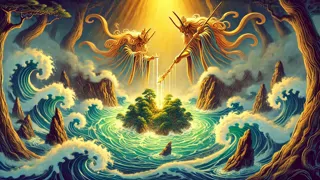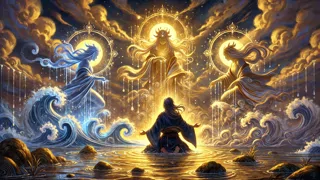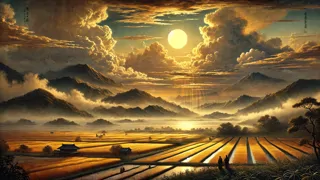Introduction
Long before human memory etched its marks into the stones and timbers of the Japanese archipelago, before emperors reigned and warriors carved their legends across rolling hills, there was only chaos—primordial, swirling, and untamed. In this formless sea, silence and possibility intermingled, cloaking the world in mist and mystery. The sky did not know the earth; the mountains slumbered beneath endless waves. And yet, from the infinite expanse, two deities arose: Izanagi-no-Mikoto and Izanami-no-Mikoto. They stood on the Floating Bridge of Heaven, gazing down at the boundless waters below. With hands entwined and spirits united, they were charged with a sacred task: to bring order, to give shape to nothingness, and to forge the very land that would become home to gods and mortals alike.
The tale that follows is not merely the foundation of Japan’s physical world but a living chronicle of longing, love, tragedy, and transformation. Each island, each river, and every whisper of wind across the ancient pines owes its existence to these divine creators. Their story is woven into the heart of the country—a mythic pulse beneath the soil, echoing through generations. Here, in the hallowed language of legend, we return to the origins: to the first swirling of the spear, the birth of islands, and the dawn of kami—the myriad spirits who would shape the destiny of all that followed.
Forging the First Land: The Birth of the Japanese Islands
From their vantage on the Floating Bridge of Heaven, Izanagi and Izanami surveyed the shapeless expanse below. Entrusted with the sacred command to bring forth land, they received a divine spear—jewel-tipped and resplendent. Izanagi gripped it firmly, his gaze steady as dawn. Together, they lowered the spear into the shifting chaos, its tip breaking the surface with a soundless ripple. As they stirred the briny depths, salty drops gathered at the point and fell back into the ocean. Each drop shimmered with potential, swirling and coalescing until, with a surge, the first island rose: Onogoro-shima—self-forming, sacred, and solitary.

Izanagi and Izanami descended to this newborn land, their feet pressing into soil untouched by sun or wind. They marveled at the stillness, the hush of a world yet to know song or sorrow. Upon Onogoro-shima, they built a towering pillar—Ame-no-mihashira, the Heavenly August Pillar. Circumnavigating it in opposite directions, they met anew beneath its shadow. Their union was both ritual and genesis, setting in motion a chain of creation that would shape all that followed.
Yet the first fruits of their union, the islands Hiruko and Awashima, emerged malformed and incomplete—a reflection of cosmic order yet unmastered. The deities pondered this mystery, seeking guidance from the higher kami. Enlightened, they reversed their ritual. This time, Izanagi spoke first, as tradition and balance demanded. The result was miraculous: eight great islands sprang forth in succession—Awaji, Shikoku, Oki, Kyushu, Iki, Tsushima, Sado, and Honshu—the backbone of Japan.
These islands were more than land; they were living spirits. Peaks rose, crowned with forests; rivers carved valleys; stones pulsed with divine energy. Each landmass carried its own essence and guardian kami, destined to shape the customs and fates of future generations. As they labored, Izanagi and Izanami gave names to mountains, rivers, and coastlines, etching language into the very bones of the archipelago. Where their hands touched, camellias and pines flourished. Where their voices echoed, cranes danced beneath the sun.
But creation was not yet complete. The divine couple looked upon their work and saw room for more—smaller islands, capes, and inlets. They sculpted these with equal care, filling the empty spaces with promise. The world, once silent, began to hum with possibility. The air shimmered with unseen kami—spirits of wind, water, and stone—gathering in anticipation of the age to come.
From the summit of Onogoro-shima, Izanagi and Izanami gazed across the newborn realm: a necklace of emerald islands strung across a sapphire sea. The task of creation had only begun, but already the land pulsed with life and wonder. The gods retreated into the forests and mountains they had shaped, their presence lingering in every rustle of bamboo and sigh of ocean breeze.
The Kami Unleashed: Creation of Deities and Nature’s Spirits
With the islands born and landscapes shaped, Izanagi and Izanami turned their divine will toward filling the world with life. Their union became the source of countless kami—deities who would embody and govern every facet of nature. Under sun-dappled forests and in the shadowed valleys, new spirits emerged: guardians of trees and stones, rivers and storms, fire and earth. Each kami took root in the land, their presence felt in the shifting breeze and the hush of ancient woods.

Among their children, many would hold sway over Japan’s fate. Amaterasu, the radiant sun goddess, burst forth in a shower of golden light, her brilliance scattering darkness and calling forth the day. Tsukuyomi, the moon god, rose cool and serene, his silver gaze gliding over tranquil seas. Susanoo, tempestuous and wild, claimed dominion over storms and seas, his laughter rolling like thunder across distant horizons. These three siblings—Amaterasu, Tsukuyomi, and Susanoo—formed the triumvirate at the heart of Japan’s divine order.
Yet the birth of new kami was not without hardship. As Izanami bore the fire god Kagutsuchi, searing pain wracked her immortal form. Flames consumed her, and with anguished cries she slipped into Yomi—the shadowy realm of the dead. Grief-stricken, Izanagi raged against his loss. His tears fell upon the land, and from them, yet more deities sprang forth—gods of sorrow and renewal, of growth and decline. In desperation and love, Izanagi descended into Yomi to reclaim his beloved. There, amid shadow and decay, he discovered Izanami transformed—no longer the radiant creator, but a being shrouded in the gloom of death.
Their reunion was brief and tragic. Bound by the laws of Yomi, Izanami could not return. When Izanagi defied her warning and gazed upon her true form by torchlight, horror overcame him. Fleeing from the underworld’s grip, he emerged into daylight and purified himself in a river—each droplet washing away death and birthing new kami. The cleansing gave rise to further deities, including Amaterasu from his left eye, Tsukuyomi from his right, and Susanoo from his nose.
Thus the world swelled with kami, each embodying a force or aspect of nature. Rivers glittered with water spirits; sacred groves pulsed with tree guardians. Villages offered rice and song to the unseen presences that shaped their fates. The land teemed with invisible life, and every stone, breeze, and flame became a vessel for the divine.
Divine Discord and Eternal Legacy: The Kami Shape Japan
With the world now vibrant with kami, the tapestry of creation grew more complex. The divine siblings—Amaterasu, Tsukuyomi, and Susanoo—each carved a path across the heavens and earth. Yet their passions and rivalries would ripple through generations, shaping not only the realm of gods but also the destiny of mortals.

Amaterasu’s brilliance ruled the High Plain of Heaven. Her warmth coaxed rice shoots from dark earth and painted cherry blossoms across gentle hills. She became the heart of harmony—her presence both a blessing and a beacon for all who dwelled below. Temples rose in her honor, their white banners fluttering in sunlit winds.
Tsukuyomi’s calm watch presided over night’s mysteries. He brought tides and cycles, his silver gaze guiding fishermen home and poets into dream. Yet his union with Amaterasu was shattered when he slew Uke Mochi, the goddess of food, in anger. Grief-stricken and furious, Amaterasu turned away from her brother, dividing night from day and setting in motion the eternal dance of light and darkness.
Susanoo’s wild spirit proved both creative and destructive. Banished from the heavens for his transgressions, he descended to earth, where his tempests battered forests and rivers alike. Yet even chaos bore fruit: Susanoo’s defeat of the fearsome serpent Yamata-no-Orochi saved the land and won him treasures that would become symbols of imperial power—the sacred sword Kusanagi foremost among them.
The world below reflected these divine dramas. Mountains trembled at the whims of kami; rivers swelled or receded according to their favor. People wove prayers into straw amulets and set lanterns adrift upon lakes, seeking blessings or appeasement. The imperial line traced its origins to Amaterasu herself, claiming descent from her grandson Ninigi-no-Mikoto, who brought rice and order to the land.
As centuries passed, the stories of these first gods became the living heart of Japan’s identity. Shrines marked places where kami lingered—at waterfalls veiled in mist, in twisted pine groves on wind-lashed coasts. Festivals echoed ancient rituals, filling the night with drums and laughter. The tale of Izanagi and Izanami, of the birth of islands and gods, endured not as memory but as presence—a sacred inheritance woven into every sunrise and whispering wind.
Conclusion
The tale of the Kojiki endures not simply as a chronicle of creation but as the pulse of Japan’s living spirit. From the swirling void to emerald mountains and bustling villages, each moment in this mythic tapestry shapes the land and those who call it home. The divine acts of Izanagi and Izanami are echoed in every ritual, every harvest, every prayer whispered to unseen kami beneath ancient cedars. Through triumph and sorrow, through discord and reconciliation, their legacy is felt in the ebb and flow of tides, in the hush that descends when cherry petals fall.
Even now, as city lights shimmer against mountain silhouettes and trains rush where once gods walked in silence, the old stories linger. They are not relics but living guides—reminding all who listen that creation is an ongoing act, that each dawn brings with it a renewal of promise. In the presence of kami, in the changing face of seasons, the heart of Japan beats on: woven from ancient matter, sustained by memory and reverence, and forever linked to the immortal deeds of its first creators.


















